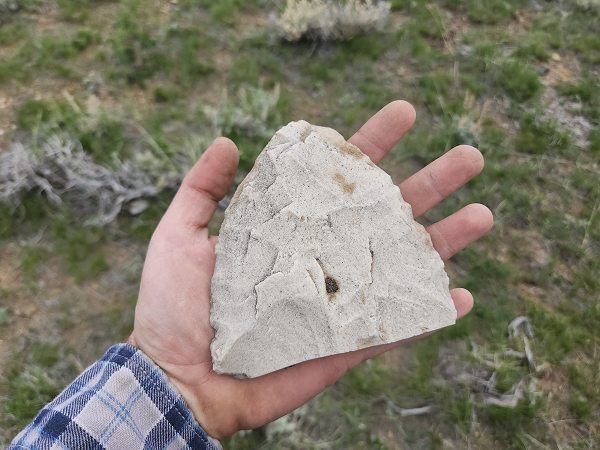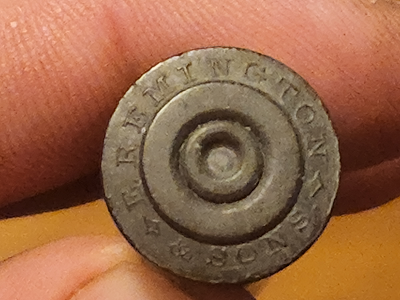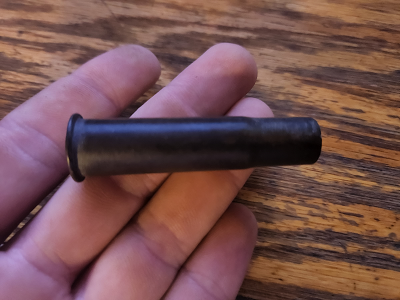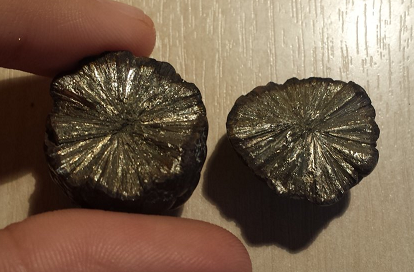-
Posts
2,475 -
Joined
-
Last visited
Content Type
Forums
Detector Prospector Home
Detector Database
Downloads
Everything posted by jasong
-
Well, most people in this particular part of the forum primarily use one brand due when it comes to daily use equipment, so... I don't get a lot of use out of other detectors myself. But my expectations for $500 equipment is much lower than more expensive equipment. I had 3 Nokta Fors Core's fail in a row and just gave up and threw the last one into my closet and never touched it again. I wouldn't do the same with a broken 6k or 7k.
-
We offshored to China to save a buck, China is in the process of re-offshoring to SE Asia to save a dime, and now every company in the world is waiting in line to have their products made now in the same manufacturing facilities. They could give a damn about quality because if Minelab asks for too much time and effort, there are 10000 businesses in line waiting to get their product manufactured instead who accept less quality. Everything is made as cheaply as possible now. Which is fine when you are buying disposable products. But is obviously pissing customers off when they are selling $6k and $10k detectors with $500 level quality. But actually think back: the 4500 failed when it first came out. My foggy recall is it was stability issues requiring main board replacements, which were promptly replaced for customers. We've seen no such thing to address the flaw with the speaker and the general lack of stability of the 6000 though, why? We know they have firmware updating, so it must mean it's mostly a hardware issue. I can't for the life of me grasp how they can sell a $6k detector, know it has flaws that literally leaves it inoperable in some places, and not be fixing the problem like they did with the 4500 unless it's just not possible to get boards re-manufactured quick enough in Malaysia due to long lines.
-

Gpx-6000 1 Year Anniversary. Is It The King?
jasong replied to Gerry in Idaho's topic in Minelab Metal Detectors
Yeah, that's pretty much what I was wondering too. If you aren't required to send the 6000 in for service to do firmware updates then there must be a magic sequence of button presses or Minelab will have to release software for the public to access the 6000 firmware upgrade capabilities it seems like. XChange3 or something. I could be missing something basic though. Or my USB cable could be bad, it's outdated micro USB and so this is the only cable I still have and it's like 6 years old. Dunno. *I'm willing to bet they saw a few years back here when we were throwing the 7000 firmware into a hex editor, trying to decompile it, and poking around looking for ways to bypass chip security and decided to nip that in the bud. -

Gpx-6000 1 Year Anniversary. Is It The King?
jasong replied to Gerry in Idaho's topic in Minelab Metal Detectors
I got curious sitting here thinking about it and just popped the 6000 open and tried browsing as a hard drive on my computer. No luck, it doesn't show up. Anyone figured out if there is some magic button combo to press to be able to access it's storage or some kind of admin mode by chance? Or maybe it requires some Minelab proprietary software to feed it an encrypted code to access the storage and firmware? -

Gpx-6000 1 Year Anniversary. Is It The King?
jasong replied to Gerry in Idaho's topic in Minelab Metal Detectors
Nope, you got it. It really is behind the speaker grill. By memory there was a rubber plug or cover you had to remove to get to it, which was basically the first thing I did once I got it opened up to reattach my control box that came undone. Oh...what's this doodad here, ah, USB port. -

Gpx-6000 1 Year Anniversary. Is It The King?
jasong replied to Gerry in Idaho's topic in Minelab Metal Detectors
Based on the underwhelming firmware updates we saw with the 7000, I'm not holding my breath. If they had solid business ethics and not just unbridled greed, they'd fix the 6000 EMI issues, or at least give us a smaller DD to alleviate them, and gain a little customer trust back. We will see if they make things right, but prior history doesn't make it seem likely. It's hidden. When you discover another in a long line of GPX 6000 flaws and try to fix the problem, you'll find it. -
Dang, you got some Google-fu going, thanks. That actually pins the date down pretty accurately for me. It looks like the closest forts were built in the early 1870's so the time span makes sense. I appreciate all the help, I learned quite a lot here. This means that it's likely someone - prospector or otherwise - at least knew about this area fairly early on, even though it seems to have escaped almost any mention in history until the 1900's. Found this too a few miles away, some kind of massive knife or something, never found one this big, and it appears to be only half of it, must have been the size of a football almost originally. Guessing it was for scraping buffalo hide or something. Or an axe head?
-

Gpx-6000 1 Year Anniversary. Is It The King?
jasong replied to Gerry in Idaho's topic in Minelab Metal Detectors
SS, unfortunately just using a DD coil alone will not produce any kind of discrim on the 6000. Aside from mental discrim if you can find some target response patterns (signal inverting on certain targets with a DD vs mono, etc) There is no reason that technically the 6000 couldn't have rough discrim capability while using a DD though, but it doesn't appear to have been built with that capability internally in the same way some of the older GPX's were. -
I got a mini backhoe and skidsteer, looking to buy a 303.5 when prices come back to Earth too. If you are looking for some equipment to use next summer to make test pits, have permits in place, and are on some gold that'd pay my towing gas and diesel use, let me know, I like digging holes.
-
Back home again, measured the shell and it's actually 2 1/4", looks like the same round and for a Sharp's still though, .44-90 so that's the one. This area was frequented by buffalo hunters and the time era makes sense. So I'm guessing that's probably what it was from as the era seems to fit in there somewhere. Land of Butch Cassidy, Buffalo Bill Cody and even some of the "Deadwood" names like Wild Bill Hickok made it out here too, all in that general time frame. Seems likely this was a stray round and not from a prospector now that it's been ID'ed though. Maybe just coincidence it was in a gold bearing area, as it seems like an unlikely round for a prospector to be carrying around for general use.
-

Gpx-6000 1 Year Anniversary. Is It The King?
jasong replied to Gerry in Idaho's topic in Minelab Metal Detectors
3rd'ing EMI. It's not a major problem, until it is. And then the detector simply won't work at all in some places, like totally useless mimicking a broken machine or coil. I'm not detecting anywhere close to power lines or civilization either myself. Also I've noticed in some wind storms (and in my part of the country it's always windy), the detector loses stability entirely too. Oddly, some days are ok though. I think it's atmospheric static, and the GPZ handles it ok while the 6000 just dies. I'd be using a mono instead, if I could. This 14" DD is too big to use in heavy, woody brush, which unfortunately is exactly what I'm spending my summer working. Thus: need a small DD. Separately, this 6000 is missing a ton of gold too as I'm regridding, even with this 11" mono. Like - Fine Gold/low gain in US mild soils level of missed nuggets. -
Nice, hope there are some lunkers waiting for you in that unworked ground! Definitely earning them in there... They aren't letting you permit an excavator in there though? Looks like a prime candidate for a dig n' detect operation.
-
What made you start digging there out of curiosity? Is it basically a test pit down to bedrock, or were you finding nuggets up top? Good luck, hope you see some nice ones.
-
Thanks guys, that's the one! That gives me something to work with now for research. Looks like it was a Buffalo hunting round, or from that Era.
-
I'm not very knowledgeable with this relic stuff, but I found a gold site that I'm trying to research historical info on and coming up short. The only thing I've found that I might be able to get a date on is this rifle cartridge. Google looks to infer this company only existed until 1896? But I'm hoping for something more accurate. The bullet itself looks to have been slightly larger than 7/16" diameter but my calipers are packed up as I'm moving right now so can't get more accurate. Close to a 44 - 40 I guess, but longer shell. Hoping someone can narrow the years down for me a bit more or potentially this round's use? Would this be a calvary/government issued round? Or an old trapper's round? Buffalo hunting? Any kind of info is helpful to potentially give me a research lead.
-
I've been pretty lucky down here in so much as the USFS seems to pass off all the permitting stuff to the BLM and let them deal with it, and the BLM is pretty mining friendly here in WY since we are a mining state. But that's unfortunate Montana is having issues now, hopefully it doesn't start down here too. I just ran into a new one in AZ - the state mining inspector just sent me a letter along with 3 "violations" saying that I'm responsible, at my cost, for fencing off and/or reclamating all old workings (they date back to 1880's to 1970's) on one of my claims. They sent me a letter saying I had 60 days to the work or they would sue me. It sounded like some kind of legislation through rules rather than laws to me, so I talked to the AZ BLM legal department and told them about it and said if anything, it's the BLM's responsibility because they should have collected bonds from the prior operators, and thankfully they agreed with me and talked to the state mine inspector about it. I'm sure other claim holders in AZ are going to get similar letters and unlawful requests though because the woman writing the "violations" said she is just starting to issue them, so people be aware of that... They seem to think people who weren't even born when something happened now bear the personal responsibility for them. In this world I've learned a few things, and one is that some people will walk all over someone they think is weaker or won't fight back. So I've resolved to always fight back no matter the size of the bully, and never back down from an unlawful challenge or wrongdoing on general principal.
-
Appears to be half of a well oxidized nodule or concretion of some sort. Common nodule forming minerals can be iron pyrite, maybe manganese. Usually they start from a "seed" in the center, can be a grain of sand or a fossil. Iron pyrite is non (or very weakly) magnetic, despite containing iron. Many different metallic minerals can form nodules though. Here is a photo from Google I snagged showing similar radial growth common in nodules, which your sample also exhibits and makes it almost certainly terrestrial in origin. This one was cracked in half by the owner and thus not oxidized internally yet though:
-
Nice work and nice gold! Detecting the mountains is sure a different game than the deserts and prairies. That's some serious work you got going there clearing the land. Crazy year for bear attacks, we've had a couple down here too already but luckily I think the people all survived this year. I haven't seen any griz for a few years myself but I'm starting to see lone wolves more often now.
-
Did you buy it from someone living at a low altitude and take it up to a high altitude? Pretty sure those stock GPZ coils have a pressure relief valve on them, could be faulty or blocked? Or at least, I thought that's the purpose of that valve looking thing... Just wondering if someone siliconed it shut or something to put into the water.
-

Retirement & Detecting / Where To Go ??? Tip #1
jasong replied to RONS DETECTORS MINELAB's topic in Detector Prospector Forum
Prescott, AZ or Grants Pass, OR are where I'd chose to move to and retire if I could. Flagstaff or Durango would be close 2nd places. Realistically though, I can't and never will be able to afford property anywhere I actually want to live in the US. The closest place with affordable real estate around gold now is probably Mexico, or somewhere else in Central/South America. -

Have I Found Somthing On My New Land?
jasong replied to JGold's topic in Rocks, Minerals, Gems & Geology
I don't see any obvious VG in there, what you are showing in these photos appears to mostly be iron oxides. The quickest way to find out if you have free gold in quartz is to buy a dolly pot and a gold pan. Or send a sample in for assay. You could have gold in there which you don't immediately see by eye. -
Nice! I was wondering how the 6000 does on speci gold like that. Good to see it's hitting it relatively deep all things considered with the target type.
-

Desert Alluvial Gold- What Form And What Distribution
jasong replied to LeighB's topic in Detector Prospector Forum
Don't confuse size sorting with density sorting though. For example: the larger rocks may go to the top of the pan, but the denser nuggets stay at the bottom. Unless you really shake the pan hard, and oscillate it up and down to bring the nuggets to the top. It requires both a high energy input plus a turbulent impulse to do such a thing. If the energy isn't both high plus chaotic, it's unlikely to overcome the natural tendency for gravity to sort things by density. But even if that succeeds to overcome gravity and bring nuggets to the top and then suddenly stop the agitation, if you leave that pan sitting in the open for a long time - geologically speaking like a million years - those nuggets will still end up sinking right back down to the bottom of the pan again because gravity never stops working and every tiny vibration will move the nugget slightly further down until it hits the bottom of the pan (bedrock) and stops. At least, assuming the wind doesn't blow all the lighter gravel off the top of the pan and expose the nuggets (soil deflation). That's why gravity and wind are the principal erosional forces that create nugget concentrations in dry, alluvial fans over time (ignoring for now the wash bottoms). They act upon the gravel daily. That isn't to say there aren't exceptions, especially in cases where landslides and floods have happened relatively recently geologically speaking and are still the dominant sorting factor involved. Rich Hill is one such place that seems to have both a massive landslide as well as potentially massive flooding. But even there, it's already clearly visible that bedrock concentration is starting to occur in some areas, and many of the surficial nugget patches appear to be the result of soil deflation. This is because over enough time, gravity and wind become the dominant erosional forces ahead of intermittent chaotic, rare events like landslides. The amount of density sorting by the gentler, but ever present erosional forces can be used to gauge the age of catastrophic events like landslides and floods, for this reason. -
It's not a meteorite and there isn't any lettering on it. Where was it found? Did it come from British Columbia or California by chance? I'd guess a serpentine cobble based on nothing but a brief visual inspection of photos. The indentions are likely from differential surface erosion in a river, which means it had a bunch of softer inclusions in it, which serpentine often does. I very highly doubt it's jadeite unless by some rare instance it came from Myanmar or maybe Central America. It could be nephrite jade though (this is chemically and mineralogically different from jadeite, not the same thing), which is similar in many ways to serpentine. Black jade is just very, very dark green jade. So it will still show translucency of a dark green when shining a very powerful flashlight on an edge. Meaning - not perfectly opaque, but again very strong LED flashlight is needed. Black serpentine might or might not show translucency depending on it's composition, but it's going to scratch with the tip of a pocket knife whereas black nephrite won't scratch with a pocket knife. In general beyond that, identifying rocks that are highly river worn such as yours is not really something that can be done by photos. You need to do tests on your own. Hardness, density, opacity are what I'd start with.
-

Desert Alluvial Gold- What Form And What Distribution
jasong replied to LeighB's topic in Detector Prospector Forum
The answer to most of your questions is "it depends where you are at" and there is no real exact way to answer them. Dependent on the amount of precipitation and severity of seasonal flooding, most nuggety gold is still found towards bedrock in these sorts of washes in US desert areas, or at least deep enough to be within the undisturbed hardpack that escapes churning during flooding. The finer gold can be commonly dispersed through the entire depth of the alluvium though. In some places you definitely can strip the first 75% or so of alluvium from a wash without too many nugget losses, but in other places you cannot. If you get out of the washes then things get more complex. Landslides can leave nuggets dispersed randomly. Eluvial processes can leave nuggets dispersed towards the surface of hillslopes, or towards the surfaces of flats due to soil deflation. This is a very common occurence on the benches/terraces of these washes in Arizona in some places. It's impossible to give a percentage of flour/nugget gold vs gold bearing cobbles. It's highly dependent on how the gold mineralized to begin with, the distance it traveled, the rock which makes up the gravel, the ore bearing rock and it's resistance to erosion, the topography, the amount of precipitation, and probably a lot of other factors. It changes place to place - some places have almost only just nuggety gold and some places have almost only flour gold. Some places specimen type (quartz bearing) gold is quite common, other places it doesn't exist at all. I've never personally detected a quartz cobble in a stream bed that had literally no visible gold, because the detection depth on such pieces is quite low and stream beds host detectable size gold usually deeper towards bedrock. I've found it very commonly in dry eluvial placers though where it's closer to surface, or eroding directly out of the vein itself. I have detected pieces of quartz in washes that had so little gold visible that I had to scrub it down with a toothbrush to see some small shiny bits. I've seen such pieces posted before by others who detected them, that were later crushed and shown to have quite a lot of gold inside.





